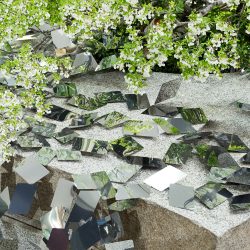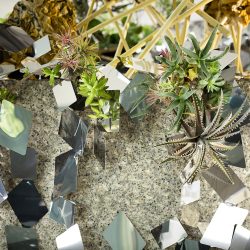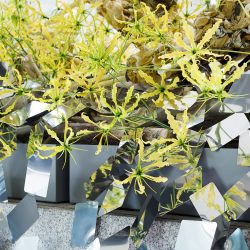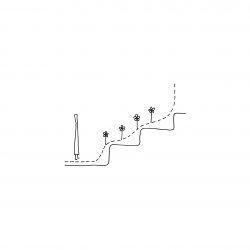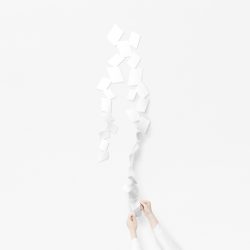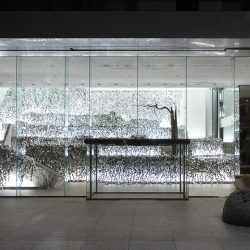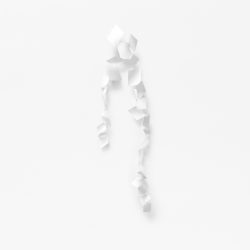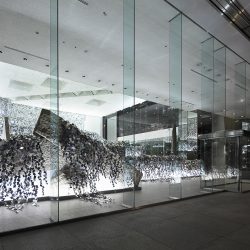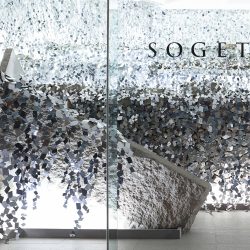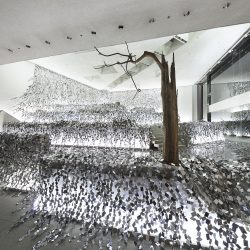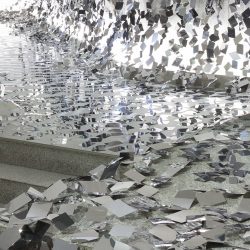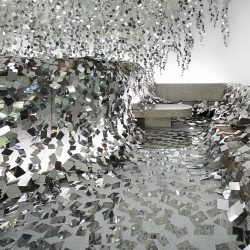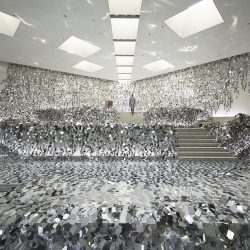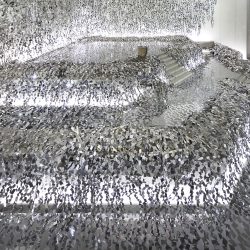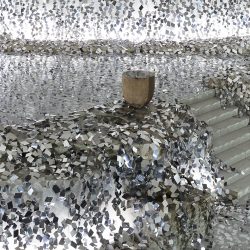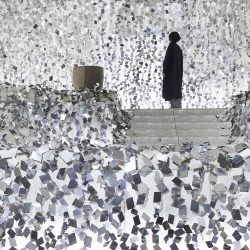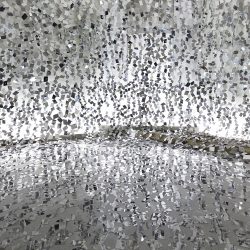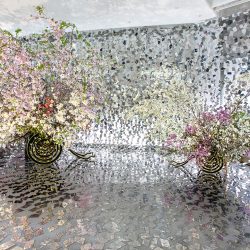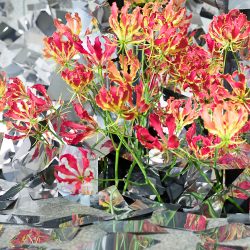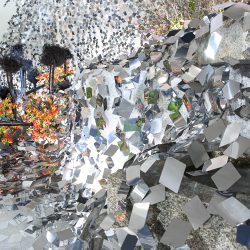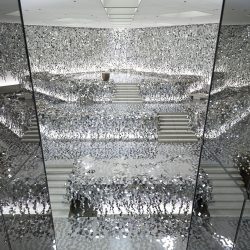FOR THE SPECIAL EXHIBITION, SOGETSU SCHOOL OF IKEBANA HAD OKI SATO OF NENDO DESIGN A LARGE-SCALE INSTALLATION, ‘KALEIDOSCOPIC IVY,’ MADE OF 40,000 INTERLACED PIECES OF RHOMBUS-SHAPED STAINLESS STEEL.
Back in 1927, the year of the foundation of the Sogetsu School of Ikebana, Sofu Teshigahara, its founder, set a different direction for the teaching of Japan’s ancient flower arrangement with the belief that the regulations and strict traditions of the art were obstacles of creative expression. Teshigahara reinterpreted Ikebana, which first originated in the 7th Century and was used as a part of Buddhist funerals, tea and other cultural ceremonies, through simplicity, humble beauty and nature in a more freestyle approach. Eliminated are the limitations in the presentational style with greater freedom being given to the choice of materials that goes beyond the conventional use of only flowers, sticks or natural grass as well as the places and occasions where an Ikebana piece can be located.
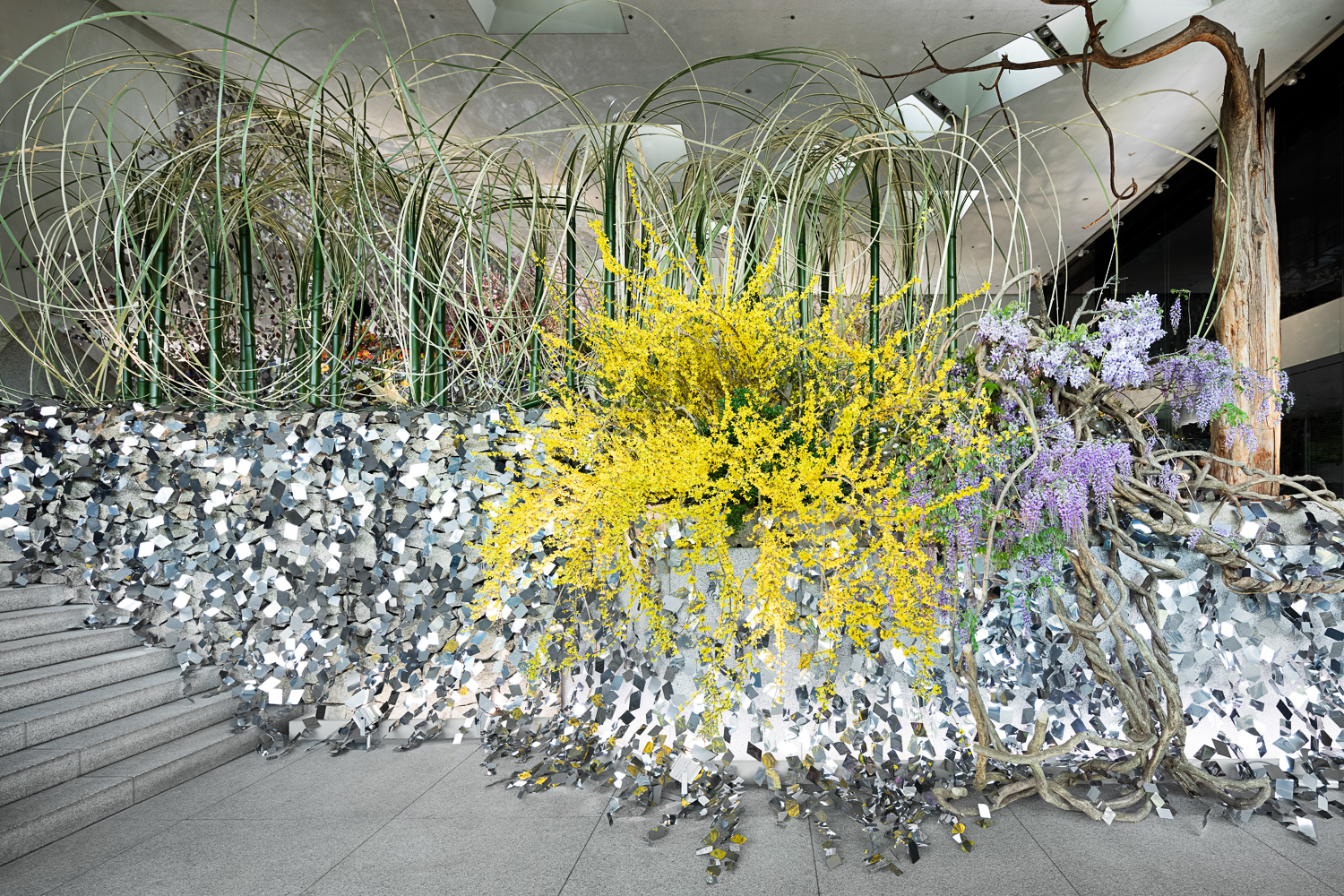
Kaleidoscopic Ivy, Photo courtesy of Takumi Ota and Kozo Sekiya of nendo
The fourth generation successor of Sogetsu, Akane Teshigahara, followed her ancestor’s rebellious spirit with her intention to celebrate the 90th anniversary of the school but in a different fashion. Normally, an Ikebana piece is created before the space is readjusted to correspond with the concept and aesthetic style of the work. ‘Hana So,’ an exhibition whose name translates to ‘firework,’ reverses the process by using the Sogetsu Plaza stone garden located on the first floor of the Sogetsu Foundation Headquarters as the subject matter for the creation of the Ikebana pieces.
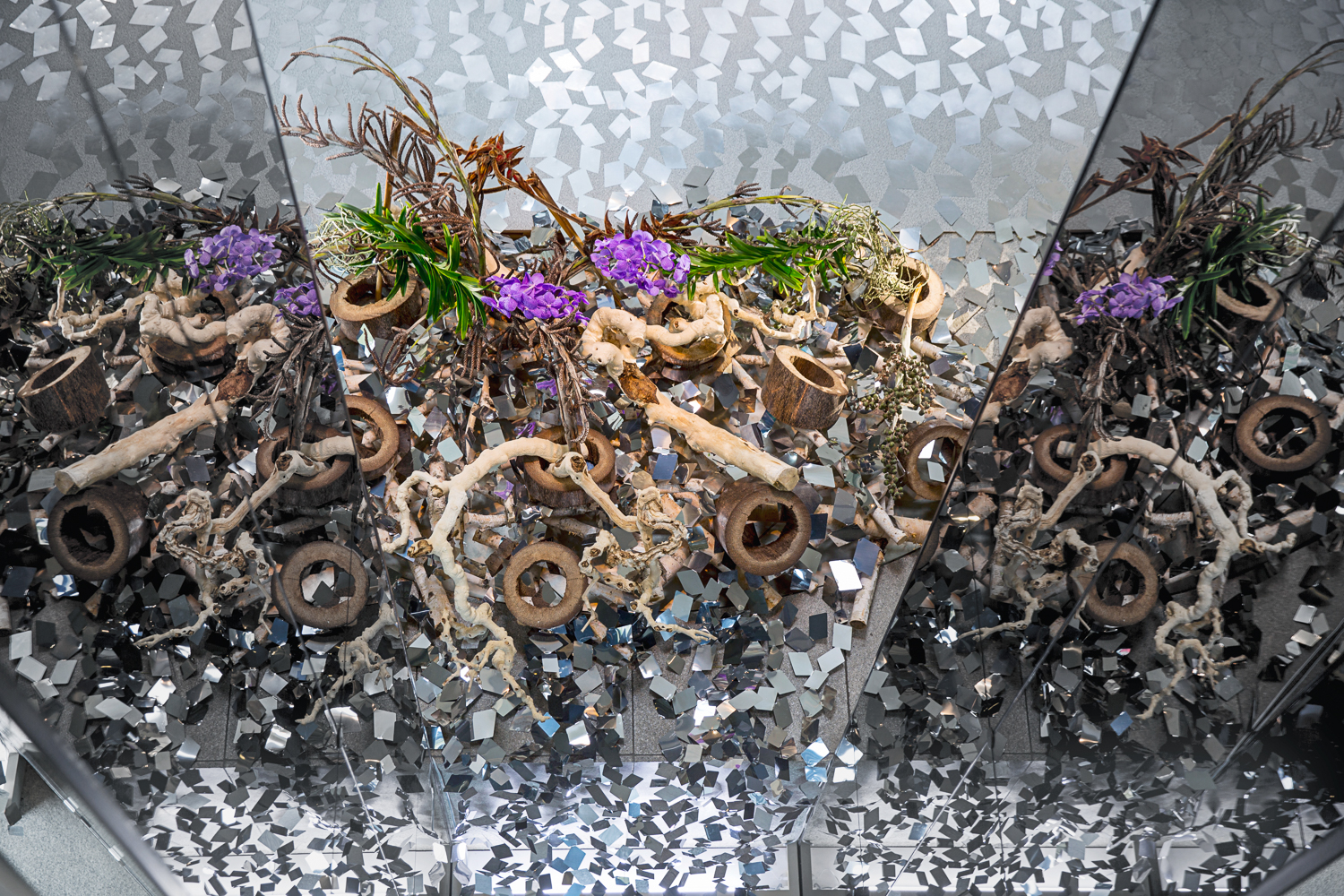
Kaleidoscopic Ivy, Photo courtesy of Takumi Ota and Kozo Sekiya of nendo
For the special exhibition, Sogetsu School of Ikebana had Oki Sato of nendo design a large-scale installation, ‘Kaleidoscopic Ivy,’ made of 40,000 interlaced pieces of 0.5 mm.-thick rhombus-shaped stainless steel. The shards were scattered around the area with the surface of polished steel delivering an intriguing impact to the space, visually linking and reflecting the different textures of the several types of stone below and the Ikebana pieces installed around the exhibition grounds. The rendered effects are dynamically varied by the spots in which viewers stand and the enlivenment of the serene dry landscape of the Zen garden designed by architect Isamu Noguchi perfectly bespeaks and corresponds with the journey and philosophy of this long-standing Ikebana school.

Kaleidoscopic Ivy, Photo courtesy of Takumi Ota and Kozo Sekiya of nendo
เมื่อปี 1927 ที่ Sogetsu School of Ikebana ก่อตั้งขึ้น Sofu Teshigahara ได้กําหนดเส้นทางของโรงเรียนสอนอิเคบานะหรือศิลปะการจัดดอกไม้ของญี่ปุ่นแห่งน้ีให้ต่างไปจากเดิม ด้วยความเชื่อท่ีว่า กฎเกณฑ์และความเข้มงวดทางประเพณีคือสิ่งขวางก้ันการแสดงออกด้านความคิดสร้างสรรค์ ทําให้จากอิเคบานะแบบดั้งเดิมที่มีต้นกําเนิดมาตั้งแต่ศตวรรษ ที่ 7 จากการเป็นส่วนหน่ึงของการบูชาพระ การมอบให้แก่ผู้ตายในพิธีทางศาสนาพุทธ การชงชา และพิธีการต่างๆ ถูกตีความใหม่ผ่านความสมถะ ความเรียบง่าย และเป็นธรรมชาติในรูปแบบฟรีสไตล์ ที่ไม่มีการจํากัดแนวทางการนําเสนอหรือกําหนดวัสดุ อยู่เพียงแค่ดอกไม้ กิ่งไม้ หรือหญ้าธรรมชาติ รวมไปถึงการให้อิสระในการเลือกสถานที่ที่อิเคบานะแต่ละชิ้นจะไปต้ังอยู่
เมื่อมาถึงทายาทรุ่นท่ี 4 อย่าง Akane Teshigahara ก็ยังคงเลือกที่จะขบถตามผู้ก่อตั้ง โดยตั้งใจจะเฉลิมฉลองปีที่ 90 ของโรงเรียนแห่งนี้ด้วยวิธีการที่ต่างออกไป เพราะจากปกติท่ีผลงานอิเคบานะจะต้องถูกสร้างสรรค์ขึ้นไว้ล่วงหน้าก่อนที่จะปรับเปลี่ยนพื้นท่ีจัดแสดงให้สอดคล้องกับแนวคิดของงาน แต่ในนิทรรศการ ‘Hana So’ ครั้งน้ีท่ีชื่อนิทรรศการมีความหมายว่าดอกไม้ไฟ กลับใช้กระบวนการย้อนกลับจากวิธีข้างต้น นั่นคือ ใช้สวนหิน Sogetsu Plaza ที่ตั้งอยู่บนบริเวณชั้น 1 ภายในอาคาร Sogetsu Foundation Headquarters ให้เป็นโจทย์หลักในกรตั้งต้นสร้างสรรค์อิเคบานะ
งานน้ี ทาง Sogetsu School of Ikebana ก็ได้ Oki Sato จก nendo มาสร้างงานอินสตอเลชั่นขนาดใหญ่ชื่อ ‘Kaleidoscopic Ivy’ ขึ้นจากการร้อยเรียงแผ่นสแตนเลสสตีลทรงสี่เหลี่ยมขนมเปียกปูน หนา 0.5 มิลลิเมตร กว่า 40,000 ช้ิน เข้าด้วยกัน และจัดวาง ให้กระจายอยู่ทั่วบริเวณ โดยใช้ประโยชน์จากพื้นผิวสแตนเลสมาสร้างอิมแพคที่น่าสนใจ ท้ังการเช่ือมโยงและสะท้อนพื้นผิวที่ต่างกันของแผ่นหินหลากหลายชนิดด้านล่างและอิเคบานะที่ติดตั้งอยู่รายรอบ การให้เอฟเฟ็คต์ที่แตกต่างกันไปตามตําแหน่งการยืนของผู้ชม ไปจนถึงการเปลี่ยนสวนหินแบบเซนที่เรียบง่ายของสถาปนิก Isamu Noguchi ให้ดูมีชีวิตและสัมพันธ์ไปกับการเดินทางและปรัชญาของโรงเรียนศิลปะดั้งเดิมของญี่ปุ่นแห่งนี้
TEXT: SUDAPORN JIRANUKORNSAKUL
www.sogetsu.or.jp


